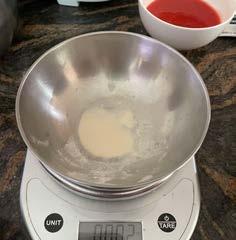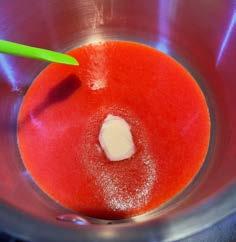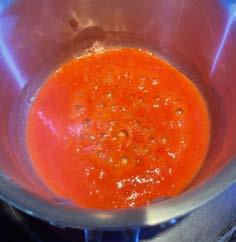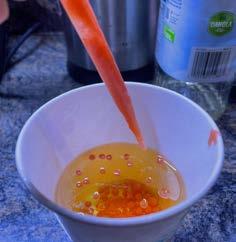
3 minute read
MOLECULAR MAGIC
from May 2021
by Anuj Khemka molecular magic
Freshman Ellen Zeng explores new cooking avenues through molecular gastronomy
Advertisement
1Zeng begins by mixing agar-agar powder and liquified strawberries in a large bowl. “The amount of agar-agar powder that I put in the mixture is 1% of the whatever fruit liquid that we start with. So, for 100 grams of oranges, you would use one gram of agar,”
Zeng said.
3Once the liquid has boiled, Zeng carefully pipettes droplets of the mixture into a cup of chilled canola oil.
There, the agar-agar powder reacts with the oil to fruity caviar-like spheres. “When the liquid falls into the oil, it solidifies,” Zeng said. “Once I’m done with that, I stir the oil.
Then normally just save the oil if I want to make more caviar in the future.” 2Zeng then boils the mixture on a stovetop. As the liquid heats, slight bubbles erupt across the surface and the agar-agar powder activates, enabling the fruity liquid to solidify in the next step. For Zeng, this process encompasses what she loves about molecular gastronomy. “It’s really interesting to see how chemicals and food can jazz up and become a whole new thing,” Zeng said.
4To complete the caviar-making process, Zeng drains the oil to reveal a cluster of strawberry-flavored balls. “I have to rinse the caviar in cold water to get rid of the oil,” Zeng said. “Afterwards, I store it in a bowl or put it in the fridge if I don’t use it immediately because they can leak if in room temperature for too long.”
5Finally, Zeng plates the strawberry caviar amongst an assortment of other strawberry-flavored ingredients to form a complete dish. “The caviar adds a nice visual and texture to the plate. It also enhances the flavor,” Zeng said.




what started as an interest first sparked by a seventh-grade home economics class has since transformed freshman Ellen Zeng’s life into a whirlwind of cakes-in-disguise, chocolate mousses, and flan.
And now, the Jefferson Chefs superstar’s latest pursuit? Molecular gastronomy, a scientific approach to cooking that yields such creations as fruit caviar, mango egg yolks, and food-flavored foam.
“I first saw some videos [of molecular gastronomy] online and on Tik Tok, and then I started doing some more research into it and buying some of the basic ingredients,” Zeng said.
Among the ingredients Zeng purchased were agar-agar and calcium lactate, two core foundations of cooking with molecular gastronomy.
“I started working with them in the past month, but I really hope I can learn more about them and start doing more interesting things,” Zeng said
As Zeng first waded into the world of molecular gastronomy, she took on fruit caviar and surprised herself by how well her first product came out. Yet, not all of Zeng’s experiments have turned out as smoothly as her initial one.
“I tried to use these big eggs using something called spherification. Normally, we use frozen reverse spherification, because it’s a lot easier, and it’s way harder to mess up, but I didn’t have anything to freeze it in, so I had to just use regular spherification. And then it completely failed and it was a big mess,” Zeng said.
Regardless of the failures, Zeng has successfully made five dishes using some aspect of molecular gastronomy. Before devouring the dish, Zeng snaps a pic to post to social media platforms, including her own food-dedicated Instagram account, @ezbakes_.
“It’s nice seeing how people react to my photos on social media. However, I mainly cook because I want to get better, and I want to learn more about everything,” Zeng said.





